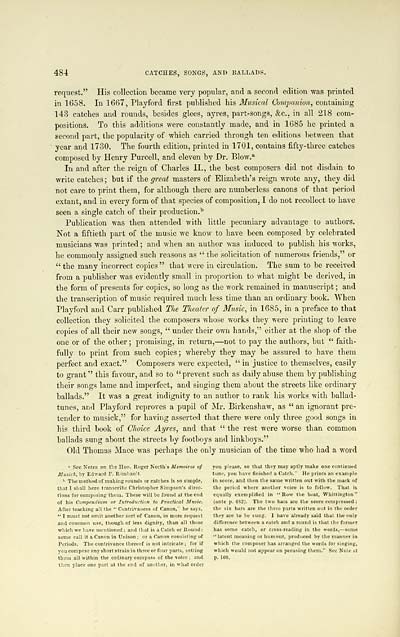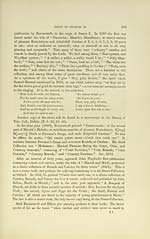Glen Collection of printed music > Printed text > Popular music of the olden time > Volume 2
(108) Page 484
Download files
Complete book:
Individual page:
Thumbnail gallery: Grid view | List view

484 CATCHES, SONGS, AND BALLADS.
request." His collection became very popular, and a second edition was printed
in 1658. In 1667, Playford first published his Musical Companion, containing
143 catches and rounds, besides glees, ayres, part-songs, &c, in all 218 com-
positions. To this additions were constantly made, and in 1685 he printed a
second part, the popularity of which carried through ten editions between that
year and 1730. The fourth edition, printed in 1701, contains fifty-three catches
composed by Henry Purcell, and eleven by Dr. Blow.*
In and after the reign of Charles II., the best composers did not disdain to
write catches; but if the great masters of Elizabeth's reign wrote any, they did
not care to print them, for although there are numberless canons of that period
extant, and in every form of that species of composition, I do not recollect to have
seen a single catch of their production.*
Publication was then attended with little pecuniary advantage to authors.
Not a fiftieth part of the music we know to have been composed by celebrated
musicians was printed ; and when an author was induced to publish his works,
he commonly assigned such reasons as " the solicitation of numerous friends," or
" the many incorrect copies " that were in circulation. The sum to be received
from a publisher was evidently small in proportion to what might be derived, in
the form of presents for copies, so long as the work remained in manuscript ; and
the transcription of music required much less time than an ordinary book. When
Playford and Carr published The TJieater of Music, in 1685, in a preface to that
collection they solicited the composers whose works they were printing to leave
copies of all their new songs, " under their own hands," either at the shop of the
one or of the other ; promising, in return, — not to pay the authors, but " faith-
fully to print from such copies; whereby they may be assured to have them
perfect and exact." Composers were expected, " in justice to themselves, easily
to grant" this favour, and so to "prevent such as daily abuse them by publishing
their songs lame and imperfect, and singing them about the streets like ordinary
ballads." It was a great indignity to an author to rank his works with ballad-
tunes, and Playford reproves a pupil of Mr. Birkenshaw, as " an ignorant pre-
tender to musick," for having asserted that there were only three good songs in
his third book of Choice Ayres, and that " the rest were worse than common
ballads sung about the streets by footboys and linkboys."
Old Thomas Mace was perhaps the only musician of the time who had a word
n See Notes on the Hon. Roger North's Memoires of you please, so that they may aptly make one continued
Music?:, by Edward F. Rimbault. tune, you have finished a Catch." He prints an example
b The method of making rounds or catches is so simple, in score, and then the same written out with the mark of
that I shall here transcribe Christopher Simpson's direc- the period where another voice is to follow. That is
tions for composing them. These will be found at the end equally exemplified in " Row the boat, Whittington "
of his Compendium or Introduction to Practical Music. (ante p. 4S2). The two bars are the score compressed ;
After teaching all the " Contrivances of Canon," he says, the six bars are the three parts written out in the order
*' I must not omit another sort of Canon, in more request they are to be sung. I have already said that the only
and common use, though of less dignity, than all those difference between a catch and a round is that the former
which we have mentioned ; anil that is a Catch or Round: has some catch, or cross-reading in the words,— some
some call it a Canon in Unison ; or a Canon consisting of "latent meaning or humour, produced by the manner in
Periods. The contrivance thereof is not intricate ; for if which the composer has arranged the words for singing,
you compose any short strain in three or four parts, setting which would not appear on perusing them." See Note at
them all within the ordinary compass of the voice ; and p. 108.
then place one part at the end of another, in what order
request." His collection became very popular, and a second edition was printed
in 1658. In 1667, Playford first published his Musical Companion, containing
143 catches and rounds, besides glees, ayres, part-songs, &c, in all 218 com-
positions. To this additions were constantly made, and in 1685 he printed a
second part, the popularity of which carried through ten editions between that
year and 1730. The fourth edition, printed in 1701, contains fifty-three catches
composed by Henry Purcell, and eleven by Dr. Blow.*
In and after the reign of Charles II., the best composers did not disdain to
write catches; but if the great masters of Elizabeth's reign wrote any, they did
not care to print them, for although there are numberless canons of that period
extant, and in every form of that species of composition, I do not recollect to have
seen a single catch of their production.*
Publication was then attended with little pecuniary advantage to authors.
Not a fiftieth part of the music we know to have been composed by celebrated
musicians was printed ; and when an author was induced to publish his works,
he commonly assigned such reasons as " the solicitation of numerous friends," or
" the many incorrect copies " that were in circulation. The sum to be received
from a publisher was evidently small in proportion to what might be derived, in
the form of presents for copies, so long as the work remained in manuscript ; and
the transcription of music required much less time than an ordinary book. When
Playford and Carr published The TJieater of Music, in 1685, in a preface to that
collection they solicited the composers whose works they were printing to leave
copies of all their new songs, " under their own hands," either at the shop of the
one or of the other ; promising, in return, — not to pay the authors, but " faith-
fully to print from such copies; whereby they may be assured to have them
perfect and exact." Composers were expected, " in justice to themselves, easily
to grant" this favour, and so to "prevent such as daily abuse them by publishing
their songs lame and imperfect, and singing them about the streets like ordinary
ballads." It was a great indignity to an author to rank his works with ballad-
tunes, and Playford reproves a pupil of Mr. Birkenshaw, as " an ignorant pre-
tender to musick," for having asserted that there were only three good songs in
his third book of Choice Ayres, and that " the rest were worse than common
ballads sung about the streets by footboys and linkboys."
Old Thomas Mace was perhaps the only musician of the time who had a word
n See Notes on the Hon. Roger North's Memoires of you please, so that they may aptly make one continued
Music?:, by Edward F. Rimbault. tune, you have finished a Catch." He prints an example
b The method of making rounds or catches is so simple, in score, and then the same written out with the mark of
that I shall here transcribe Christopher Simpson's direc- the period where another voice is to follow. That is
tions for composing them. These will be found at the end equally exemplified in " Row the boat, Whittington "
of his Compendium or Introduction to Practical Music. (ante p. 4S2). The two bars are the score compressed ;
After teaching all the " Contrivances of Canon," he says, the six bars are the three parts written out in the order
*' I must not omit another sort of Canon, in more request they are to be sung. I have already said that the only
and common use, though of less dignity, than all those difference between a catch and a round is that the former
which we have mentioned ; anil that is a Catch or Round: has some catch, or cross-reading in the words,— some
some call it a Canon in Unison ; or a Canon consisting of "latent meaning or humour, produced by the manner in
Periods. The contrivance thereof is not intricate ; for if which the composer has arranged the words for singing,
you compose any short strain in three or four parts, setting which would not appear on perusing them." See Note at
them all within the ordinary compass of the voice ; and p. 108.
then place one part at the end of another, in what order
Set display mode to: Large image | Transcription
Images and transcriptions on this page, including medium image downloads, may be used under the Creative Commons Attribution 4.0 International Licence unless otherwise stated. ![]()
| Special collections of printed music > Glen Collection of printed music > Printed text > Popular music of the olden time > Volume 2 > (108) Page 484 |
|---|
| Permanent URL | https://digital.nls.uk/91363290 |
|---|
| Shelfmark | Glen.254a |
|---|---|
| Additional NLS resources: | |
| Attribution and copyright: |
|
| Description | Scottish songs and music of the 18th and early 19th centuries, including music for the Highland bagpipe. These are selected items from the collection of John Glen (1833 to 1904). Also includes a few manuscripts, some treatises, and other books on the subject. |
|---|
| Description | The Glen Collection and the Inglis Collection represent mainly 18th and 19th century Scottish music, including Scottish songs. The collections of Berlioz and Verdi collected by bibliographer Cecil Hopkinson contain contemporary and later editions of the works of the two composers Berlioz and Verdi. |
|---|

